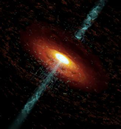 Tutors: Luigi Foschini, Patrizia Romano, Stefano Vercellone
Tutors: Luigi Foschini, Patrizia Romano, Stefano VercelloneLasting: 3 years. PhD thesis. The sky observed at high energies shows that active galactic nuclei (AGN) constitute the largest population of gamma-ray emitters. In particular, AGN emitting jets of matter at speeds close to those of light (relativistic jets) dominate. Although the central engine of these sources is the same - a supermassive spacetime singularity (black hole) accreting matter along the equator and ejecting it from the poles - there are different ways in which it manifests itself to observations (quasar, BL Lac Objects, Seyfert, misaligned AGN, ...), it changes over time both on human (changing-look AGN) and cosmological (evolution) time scales, it interacts with the host galaxy (feedback). Therefore, it is possible to study one or more of these AGN, both by analyzing the data from instruments operating at high energies (X and gamma rays; both from archives and from observations to be requested as needed and depending on the occurrence), but also knowing how to understand the information coming from observations at any other frequency (radio, infrared, optical, ultraviolet), and interpreting the information obtained on the basis of known or under development or to be developed theories. The degree of difficulty is related to the type of thesis and the availability of the students: simple for a three-year degree thesis, more complex for a master's degree, which can also lead to the publication of an article. Obviously, in the case of a PhD, it is expected that the candidate will be able to start his / her own original line of research within the limit of three years, producing many publications. For the more demanding theses, it is also possible to evaluate the possibility of spending short periods abroad to learn particular techniques. |